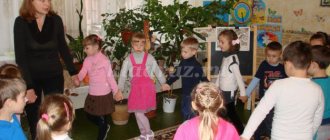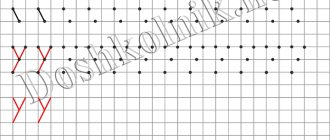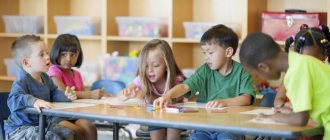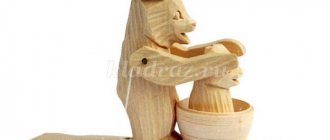Master class “Use of mnemonics in the work of a teacher”
- September 9, 2016
Competition “Methodological piggy bank of a teacher - 2016”
Nomination “Methodological piggy bank of a preschool teacher”
“Teach a child some words unknown to him - he will suffer for a long time and in vain, but associate twenty such words with pictures, and he will learn them on the fly.”
K.D. Ushinsky
Today I will try to explain the concepts of “Mnemonics” and “Mnemotable”, introduce you to the stages of work and show various options for using mnemonic tables.
Slide 3
Teachers often hear the following words from parents: “We don’t remember our poems!!! Can’t quickly remember the text, gets confused in the lines, rearranges words.”
The fact is that mostly children have developed visual memory, rarely children have developed auditory memory, so we need to find techniques that would develop children's memory.
Slide 4
MNEMOTECHNIQUES – a system of special techniques that ensure effective memorization, preservation and reproduction of information. Mnemonics are designed to facilitate memorization and increase memory capacity by forming additional associations.
RELEVANCE OF THE SELECTED TOPIC:
1. Mnemonics make it easier for children to master coherent speech.
2. The child, relying on memory images, establishes cause-and-effect relationships and draws conclusions, thereby developing logical thinking.
3. The use of mnemonics and the use of generalizations allow the child to systematize his direct experience.
Slide 5
TASKS:
1. Develop the ability to understand and tell a text using a graphic analogy.
2. To develop in children mental activity, intelligence, observation, the ability to compare, and identify essential features.
3. Develop mental processes in children: thinking, attention, imagination, memory.
4. Contribute to the solution of inventive problems of a fairy-tale, playful, environmental, and ethical nature.
5. Teach children correct sound pronunciation.
6. To cultivate in children the need for verbal communication for better adaptation in modern society.
Slide 6
A mnemonic table is a diagram that contains certain information. Looking at this diagram, we can describe any animal, what parts of the body it consists of, what kind of ears the animal has, what kind of tail it has, how it moves, what sounds it makes.
Slide 7
Mnemonic tables are also especially effective when learning poems. The point is this: for each word or line, a picture is created; Thus, the entire poem is sketched schematically. After which the child reproduces the entire poem from memory, using a graphic image.
At the initial stage, the adult offers a ready-made plan (scheme), and as they learn, children become involved in the creation process and create their own diagrams.
Slides 8-9
Now I invite you to participate in compiling a mnemonic table when learning a poem. Listen to him:
“THE FIR-STREET” by N. Nishchev
In front of us is a Christmas tree: Cones, needles. Balls, lanterns, Bunnies and candles, Stars, people.
– In front of you are sheets of paper and pencils. I invite you to draw with me. Let's draw schematically.
- “There is a Christmas tree in front of us.” What can we draw for this line? (Christmas tree). Right.
The next line is “Needle cones.” Let's draw... Etc.
– Our poem is “drawn”, the mnemonic table is ready. Now, looking at your mnemonic tables, read the poem without relying on the text. Did you like it? This way you can draw any poem from simple to complex.
– I would like to note that children really like to draw and work with mnemonic tables. A visual diagram acts as a plan for a speech utterance. The child knows where he can start, how to continue and refine his story, and how to complete it. And the process of learning a poem becomes interesting and fast.
I am sure that you will agree with me if I say that what is drawn is imprinted in memory better, because not only the word, but also the image is fixed.
Slide 10
– I would like to offer another type of work with mnemonic tables. This is the use of ready-made schemes of pure sayings and nursery rhymes.
I offer several cards as a sample. Looking at the pictures, I ask you to read the clear sentence. Now close the text and bend it. And then I propose, based only on the diagram, to tell the truth.
– Do you think using a flashcard helps you remember quickly?
Slide 11
– Mnemonic tables can also be used when composing descriptive stories. Looking at the diagram, you can describe any profession, clothing, seasonal changes, or tell a fairy tale.
Slide 12
– Using this diagram as an example, I suggest you play, you guess any vegetable or fruit and, based on the diagram, tell us about it, and we will try to guess it! Try…..
Slide 13
– Using these examples, in a playful way, you can teach your children a poem or retell a literary text, learn how to write a descriptive story, automate the sounds, etc.
This memorization technique can be useful not only for children, but also for you. Just try it and see the result for yourself!
Slide 14
– I think that all the games with mnemonic tables that I showed you today will be useful to you and your children will also like them. They can be used both at work and in the home playroom. It's very interesting and exciting!
results
- children's knowledge about the world around them increases;
- there is a desire to retell texts and come up with interesting stories;
- there is an interest in learning poems and nursery rhymes;
- vocabulary reaches a higher level;
- children overcome timidity and shyness, learn to behave freely in front of an audience.
conclusions
Mastering the techniques of working with mnemonic tables helps in the development of basic mental processes - memory, attention, imaginative thinking, and also reduces the time of learning coherent speech for preschool children. Mnemonics helps make the memorization process simpler, more interesting, and creative.
Presentation for the master class
Author: Natalya Vyacheslavovna Zastolskaya, senior teacher of MBDOU Combined Kindergarten No. 72 of the Sergiev Posad Municipal District.
Lesson on speech development in the middle group using mnemonics and model diagrams
A lesson on speech development in the middle group using mnemonics and model diagrams based on the fairy tale “Teremok”.
Program content:
- learn to name the distinctive features of wild animals (wolf, hare) using a mnemonic table;
- activate words and expressions in speech that allow you to begin and end a fairy tale;
- teach children to pronounce words clearly and distinctly, develop intonation expressiveness.
- continue to develop mental processes: memory, attention, visual and effective thinking;
- develop the ability to correlate sound symbols with images.
- cultivate a kind attitude towards animals;
- to accustom children to follow the basic rules of cultural behavior.
Visual material:
- mnemonic tables (for the fairy tale “Teremok”);
- characters from the tabletop theater based on the fairy tale “Teremok”
- caps of heroes based on the fairy tale “Teremok”.
Progress of the lesson.
Educator:
Hello guys!
Children:
Hello
Educator:
Guys, did guests come to us from the fairy tale “Teremok”?
Who is this? Children:
Bunny and wolf.
Educator:
Do you think the hare and the wolf are wild or domestic animals?
Children:
These are wild animals because they live in the forest.
Educator:
That's right, well done! How about I turn into a bunny and tell you about him using a table like this?
Storytelling using the mnemonic table “Hare”
Hare
- This is not a domestic animal, but a wild one. He lives in the forest. He has four legs. The body is covered with white wool in winter, and gray in summer. He has a small, short tail. There are two long ears on the head. The mother hare feeds her cubs with milk. When it grows up, the hare eats carrots, grass, cabbage, and in winter it eats tree bark or twigs.
Educator:
Did the bunny have an interesting story? And who will try to tell about the wolf, how angry and angry he is? Go... tell me about the wolf.
Storytelling using the mnemonic table “Wolf”
Wolf
wild animal. He lives in the forest. He has four legs. The body is covered with thick gray fur. The wolf has a long tail and very good hearing and scent. The she-wolf feeds her cubs with milk. The wolf is a predator, it has sharp teeth.
Educator:
Now let’s play a game called
“Mirror”,
I will show you the movements, and you must guess what animal I depicted and repeat the movements after me.
(Rooster, Bear, Sparrow, Ram) After the game, the children sit down in their places.
Educator:
Guys, remember what heroes are in the fairy tale “Teremok” and what nicknames each animal has: Mouse... (Norushka), Frog... (Wahakushka), Bunny... (Runner), Fox... (Sister), Top (Grey Barrel), Bear ( Toptyshka).
Educator:
Come on, you guys turn into our heroes from a fairy tale and tell us about yourself using the table.
I distribute hats upon request.
Educator:
A small mouse ran and said:
Mouse:
A small wild animal that sometimes lives next to humans. In nature, a mouse lives in a hole. She has short fur and a long tail. The mouse feeds on grain or beans.
Educator:
Thank you little mouse.
Educator:
A frog-frog jumped up and croaked.
Frog:
Lives in swamps or ponds. She has big eyes and a long tongue, with which she gets food. The frog feeds on mosquitoes and midges.
Educator:
Thank you frog!
Educator:
The little fox-sister came running, wagging her tail and saying.
Chanterelle:
This is a wild animal that lives in the forest and steppe. She has red fur and a very beautiful long tail. Mother feeds her cubs with milk. But the fox is a predator. It feeds on small animals and birds.
Educator:
Thank you little fox-sister.
Educator:
An awakened teddy bear wandered towards us and roared in his loud voice:
Bear:
Wild animal lives in the forest. In winter, the bear sleeps in a den. He has four paws, the skin of a bear is brown, brown in color. He is a predator and is very good at climbing trees. A mother bear feeds her cubs milk. He loves sweets, fish, meat, berries. The animal is omnivorous.
Educator:
Thank you, teddy bear!
Educator:
Well done guys, you know how to talk about yourself and show yourself.
Educator:
Now we will all play with the ball.
The game is called “Question and Answer”. (Stand in a circle, I throw the ball from the center and ask a question, and you throw the ball back to me and say the answer) Educator:
Where does the mouse live?
- In a hole,
where does the frog live?
- In the swamp.
The bunny lives -
Under a bush
.
Where does the fox live? - In the hole.
What is the name of the wolf's house?
- Lair.
What is the name of the bear's house?
- Den.
Which animal is a predator?
– Wolf, Fox, Bear
.
Educator:
What a great fellow you are, you told and answered everything correctly.
Who can tell me the name of the fairy tale in which all these animals lived together in one house? Children:
“Teremok”
Educator:
What words does the fairy tale “Teremok” begin with?
Children:
There is a tower in a field, it is neither low nor high... Then the teacher offers to play a fairy tale with the help of tabletop theater characters.
Exercises for children and teenagers
Until the age of 14, a child develops abstract logical thinking and remembers best what he personally experiences. Mnemonics allows you to connect associations from life experience with abstract concepts from the curriculum. Thus, the process of memorization and learning as a whole is simplified.
Next, we will look at the most accessible and effective methods.
Story method
This technique is suitable when a child needs to remember a series of words that are absolutely unrelated to each other. To do this, you should imagine their meanings in your imagination and come up with a story using them. The funnier or more fantastic the story, the simpler and better it will be remembered. The technique is suitable even for younger schoolchildren.
Let's look at an example. Let's take a list of words:
- Bee.
- Rain.
- Sofa.
- Pan.
- Borsch.
- Tulip.
- Postman.
- Tiger.
- Corn.
- Toothbrush.
Let's try to invent a story with these words.
Postman Pechkin rode on a tiger through a corn field. Out of nowhere a swarm of bees , but then it started to rain and dispersed them all. The rain was magical, and instead of corn, tulips . Then Pechkin noticed a tent in the middle of the field. a sofa in it , and borscht in the stove . And sticking out of it was not a ladle, but a toothbrush .
In this way, you can compose a story from a list of products, names of school subjects, plans for the weekend, etc.
Chain method
The task is to combine several images into a single chain. It is important to ensure that all words are consistent.
For example, let's take the following words: horse, daisies, sandwich, chess, history, chimpanzee. Let's see how you can create a chain from them.
The horse , bathing in the grass with daisies , chewed a sandwich and watched how and chimpanzees taught history chess .
As you can see, words are strung onto a sentence like beads on a string. It is enough to remember the first word. The rest will follow on their own.
Cicero's method
Other common names for this technique are “Roman Room Method” and “Mnemonic Room”. Why, exactly, Cicero? This ancient Roman politician and orator never used cheat sheets and could reproduce many quotes, facts, names and historical dates from memory.
When Cicero prepared for speeches, he walked around the house and mentally placed the key points of his speech on each object.
So, the essence of the method:
- You need to choose a room. This could be a room in your apartment or an auditorium where you are planning a performance.
- Then you need to attach a unit of information to each item: a keyword, a sentence or a whole thought. It is better to do this by moving your gaze clockwise. This will make it easier to remember.
- During the performance, it is enough to remember the situation in the rehearsal room. The necessary information will emerge in memory by itself.
More and more new images can be attached to the same location. But from time to time it is better to change the room so that the information does not get confused.
This technique can use not only rooms, but also the road from home to school, for example. Pay attention to what you see: a bench, an urn, a lantern, a store, three birch trees, a gate, a flowerbed, etc. Attach images from the information you remember to each object, and during the story, recreate the entire path in your memory.





